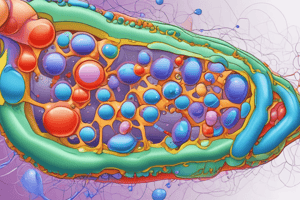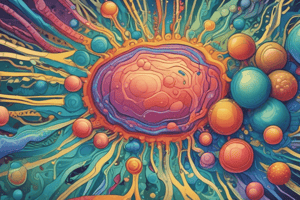Podcast
Questions and Answers
Which of these macromolecules is NOT commonly found in the plasma membrane?
Which of these macromolecules is NOT commonly found in the plasma membrane?
- carbohydrates
- proteins
- nucleic acids (correct)
- fatty acids
Plasma membrane proteins that move ions in and out of cells using active transport are called
Plasma membrane proteins that move ions in and out of cells using active transport are called
- transporters. (correct)
- channels.
- anchors.
- receptors.
If a phospholipid is located in the outer layer of the bilayer in a vesicle, where will it end up when the vesicle fuses with the plasma membrane?
If a phospholipid is located in the outer layer of the bilayer in a vesicle, where will it end up when the vesicle fuses with the plasma membrane?
- the cytosolic face of the bilayer (correct)
- the extracellular face the bilayer
- randomly on one side or another
- Vesicles cannot fuse with the plasma membrane.
The fluidity of a membrane is increased by
The fluidity of a membrane is increased by
A cell membrane made up primarily of lipids with which characteristics would be the least fluid (i.e., most stiff)?
A cell membrane made up primarily of lipids with which characteristics would be the least fluid (i.e., most stiff)?
Where are new phospholipids made?
Where are new phospholipids made?
Detergent molecules are ___________ in nature and bind with membrane proteins and membrane lipids to disrupt their interactions and release the proteins from the membrane.
Detergent molecules are ___________ in nature and bind with membrane proteins and membrane lipids to disrupt their interactions and release the proteins from the membrane.
In a fluorescence recovery after photobleaching (FRAP) experiment, a fluorescently tagged membrane protein, A, shows very little recovery of fluorescence ten minutes after photobleaching, while membrane protein B shows a rapid increase in fluorescence after bleaching, recovering nearly 80% of its original fluorescent signal by ten minutes. Based on this information, which of the following statements can be made?
In a fluorescence recovery after photobleaching (FRAP) experiment, a fluorescently tagged membrane protein, A, shows very little recovery of fluorescence ten minutes after photobleaching, while membrane protein B shows a rapid increase in fluorescence after bleaching, recovering nearly 80% of its original fluorescent signal by ten minutes. Based on this information, which of the following statements can be made?
Which type of movement is the least common for lipids in a bilayer?
Which type of movement is the least common for lipids in a bilayer?
How is the protein shown in the diagram associated with the plasma membrane?
How is the protein shown in the diagram associated with the plasma membrane?
Flashcards are hidden until you start studying
Study Notes
Plasma Membrane Characteristics
- The plasma membrane is not commonly composed of a specific macromolecule (not specified).
Transport Proteins
- Proteins that facilitate active transport of ions in and out of cells are called plasma membrane proteins.
Phospholipid Dynamics
- When a vesicle fuses with the plasma membrane, phospholipids from the outer layer of the vesicle will end up on the outer layer of the plasma membrane.
Membrane Fluidity
- The fluidity of a membrane is increased by certain factors (not specified).
- A cell membrane primarily composed of lipids with saturated fatty acid tails and no double bonds would be the least fluid (i.e., most stiff).
Phospholipid Synthesis
- New phospholipids are made in the endoplasmic reticulum (not specified).
Detergent Interactions
- Detergent molecules are amphipathic in nature, allowing them to bind with membrane proteins and lipids, disrupting their interactions and releasing proteins from the membrane.
Fluorescence Recovery After Photobleaching (FRAP)
- In a FRAP experiment, a fluorescently tagged membrane protein with little recovery of fluorescence after photobleaching is likely to be immobile or have limited lateral mobility.
- A protein with a rapid increase in fluorescence after bleaching, recovering nearly 80% of its original signal, is likely to be highly mobile and able to diffuse freely.
Lipid Movement
- The least common type of movement for lipids in a bilayer is lateral movement (not specified).
Protein Association
- The protein shown in the diagram is associated with the plasma membrane through a transmembrane domain, which spans the entire membrane.
Studying That Suits You
Use AI to generate personalized quizzes and flashcards to suit your learning preferences.



